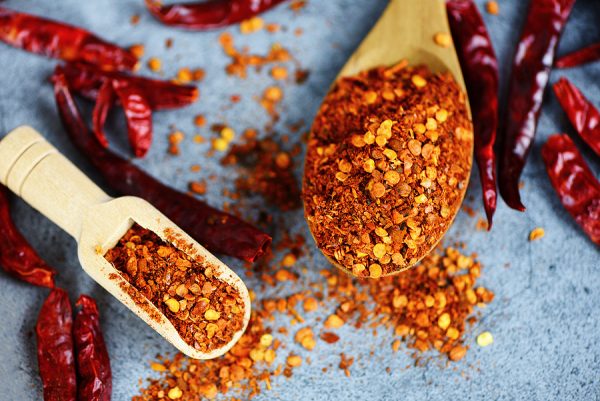There is a misconception about hot and spicy foods.
Some people think they’re dangerous – that they’ll actually burn the linings of the esophagus and stomach. For years it was believed foods like hot peppers and curry were the culprits behind ulcers.
A lot of folks still hold to this line of thinking. I run into them on a daily basis. They avoid anything with a little heat in it.
And boy are they missing out!
While it’s true that spicy foods might irritate an ulcer if you already have one, these foods certainly aren’t the cause of ulcers. In fact, the capsaicin found in chili peppers may actually prevent, and even help heal ulcers.
Better yet, nearly all spicy foods have cancer-fighting properties. They relieve inflammation and chronic pain. They support your cardiovascular health, reduce your chances of diabetes and can help you drop a few pounds.
Here’s Why I Love Chili Peppers
I’m a big fan of any food that has multiple health benefits, and chili peppers easily fall into that category. Here is a quick round-up of what adding a little heat to your meals can do for you:
Protect against cancer. Both the capsaicin found in chili peppers and the curcumin in curry show great promise in the fight against cancer. Capsaicin can literally change the expression of genes involved in the growth, survival and spread of cancer cells. It is shown to induce cancer cell death in 40 distinct cancer cell lines.
Curcumin has a similar appeal. It helps prevent precancerous cells from turning into full-blown cancer, kills cancer cells and helps to stop more cancer cells from growing.
Stave off pain and inflammation. Curcumin shuts down inflammation by blocking enzymes that produce pain. In the majority of cases, people who take curcumin are able to stop taking dangerous anti-inflammatory drugs within just weeks. All forms of arthritis, including gout and other joint pain are responsive to curcumin for ongoing pain managements.
Give your heart a chance. People who eat chili peppers four times a week or more have a 40% lower risk of dying of a heart attack compared to those who avoid them. The risk of suffering a fatal stroke is cut by more than half.
Ward off diabetes. Curcumin treatment appears to improve overall function of beta cells, which are necessary for proper insulin function. It also has a favorable effect on insulin resistance, hyperglycemia and diabetic complications. When pre-diabetic patients took a curcumin supplement for nine months, none of them progressed to a full-fledged diabetes diagnosis.
Kick up your weight loss. Chili peppers, capsaicin, red pepper, curcumin… all of these spices crank up your internal metabolic furnace, a function called thermogenesis. They work by increasing healthy brown adipose tissue, or BAT, which induces thermogenesis and increases energy expenditure. This, of course, burns off and helps to inhibit the formation of fat and fatty tissue.
At the same time, these spices suppress appetite and can boost the health of your gut microbiome.
With all of these health benefits – and so many more – isn’t it time to get spicy with your food?
Feeling Hot, Hot, Hot…
Now I’ll be honest with you. The last time I visited Pepper Palace, a store that specializes in hot sauces, seasonings and rubs, I tasted a few items that just about burned the hairs off my chest.
Unless you like that type of heat, you don’t need to go to that sort of extreme. The only thing that matters is that you’re eating foods that contain capsaicin or curcumin. The heat level is your choice.
That being said, there are more kinds of chili peppers than you can shake a stick at. They extend from the extremely mild banana pepper to the fiery ghost pepper – with many other options in between.
You can buy red pepper, black pepper and crushed pepper at any store.
There are also plenty of hot sauces that are readily available like Tabasco, Louisiana and Crystal hot sauces – along with many more that are hotter and more complex.
There are just as many different types of curries available at varying heat levels.
If you don’t like heat, I recommend starting off with the milder varieties. Then, start adding your choices to the foods you make. It’s not hard to do.
Add sliced peppers to your wraps and salads. Toss them into your omelets, soups and stews. Turn them into salsas and dips. Make them the spicy component in your stir-fries.
Experiment with curries… Thai curry, Indian curry, red curry and green curry. All of them are great when you combine them with fresh vegetables and clean proteins.
Liberally apply black, red, crushed and other prepared peppers to your meals.
Don’t be afraid of hot sauces. But make sure you choose one that isn’t loaded with sodium and other additives. Drizzle it over fish, meat, eggs and veggies.
With just a little bit of experimentation, you’ll find the flavor and heat level that suits you the best. After that? Enjoy!
SOURCES:
Lv J, et al. Consumption of spicy foods and total and cause specific mortality: population based cohort study. BMJ. 2015 Aug 4;351:h3942.
Clark R, et al. Anticancer Properties of Capsaicin Against Human Cancer. Anticancer Res. 2016 Mar;36(3):837-43.
Aggarwal BB, et al. Anticancer potential of curcumin: preclinical and clinical studies. Anticancer Res. 2003 Jan-Feb;23(1A):363-98.
Kuptniratsaikul V, et al. Efficacy and safety of Curcuma domestica extracts compared with ibuprofen in patients with knee osteoarthritis: a multicenter study. Clin Interv Aging. 2014 Mar 20;9:451-8.
Bonaccio M, et al. Chili Pepper Consumption and Mortality in Italian Adults. J Am Coll Cardiol. 2019 Dec 24;74(25):3139-3149.
Chuengsamarn S, et al. Curcumin extract for prevention of type 2 diabetes. Diabetes Care. 2012 Nov;35(11):2121-7.
Zhang D, et al. Curcumin and Diabetes: A Systematic Review. Evid Based Complement Alternat Med. 2013; 2013: 636053.
Zheng J, et al. Dietary capsaicin and its anti-obesity potency: from mechanism to clinical implications. Biosci Rep. 2017 May 11;37(3). pii: BSR20170286.
Yoneshiro T, et al. Nonpungent capsaicin analogs (capsinoids) increase energy expenditure through the activation of brown adipose tissue in humans. Am J Clin Nutr 2012;95:845–50.




